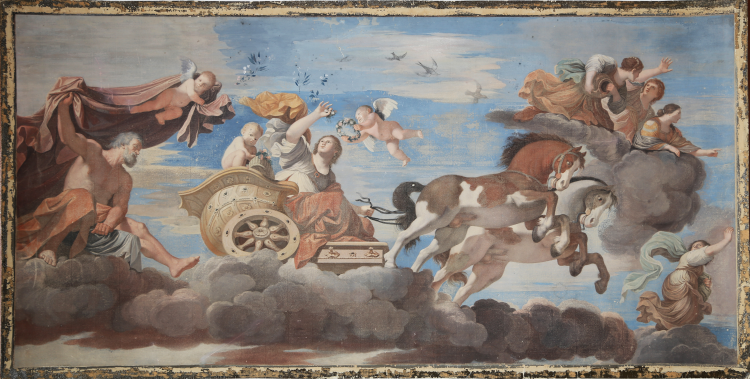



| Reference: | S44279 |
| Author | Giovanni VOLPATO |
| Year: | 1782 ca. |
| Measures: | 900 x 440 mm |


| Reference: | S44279 |
| Author | Giovanni VOLPATO |
| Year: | 1782 ca. |
| Measures: | 900 x 440 mm |
Etching with engraving, c. 1782, based on a drawing by Stefano Tofanelli (1752-1812).
The print reproduces Guercino's fresco in Cardinal Del Monte's Casino Ludovisi in Rome. Aurora is depicted as a young goddess in a chariot drawn by two horses, before whom Night flees while a flying genie crowns Aurora with flowers and another, in the chariot, scatters flowers all around; to one side, on the bed, is her old husband Titone; above, three young women depict as many stars, one of whom pours dew from an urn.
The print belongs to the engraving cycle dated 1782 by Giovanni Volpato based on a drawing by painter Stefano Tofanelli. The engraving reproducing the Aurora, almost a meter wide, is dedicated to the influential painter friend, connoisseur and networker, Angelika Kaufmann, who returned to Rome from England that year. The cycle, also executed in etching and engraving, is certainly still the best known and most popular today, although it declines the Casino scenes in a decidedly neoclassical and "cooled" language compared to the original paintings. Volpato, after moving to Rome, had become the most active and sought-after interpreter in the field of graphic translation at the turn of the century. Having moved to Rome in 1771 from Bassano del Grappa, he had made a strong name for himself in the Roman engraving world, opening a school and a workshop selling to the public and then founding, in 1785, a very active ceramic factory. His engravings dedicated to Raphael's Loggias and then to the Galleria Farnese had an extraordinary international circulation, and in this wake of the classicist axis romano were those by Guercino, whose Aurora, was considered by some authors and artists to be on a par with if not superior to Guido Reni's fresco of the same theme. The dedication to Angelika, whose importance as a key-figure in directing artistic and cultural choices in neoclassical Rome has not been sufficiently emphasized, is set at 1782 by Giorgio Marini, at the beginnings therefore of Volpato's relationship with the influential artist, to whose salon sphere he had wide access through her husband, Antonio Zucchi, also from Veneto. Indeed, it was Kauffmann herself who arranged the marriage of Giovanni's son, Giuseppe Volpato, to Maddalena Riggi, sister of the powerful banker Carlo Ambrogio, in 1788. Maddalena was among other things the Milanese beauty whom Goethe met at Castelgandolfo in the villa of Thomas Jenkins, an English art dealer and banker, who had moved to Rome in 1786 (see I. Marianelli Mariani, La fortuna visiva nei dipinti di Guercino nella Villa Ludovisi, p. 3).
Magnificent proof, printed on contemporary laid paper and finely tempera-colored in period. Example applied on ancient support and lacking the inscriptions at the bottom, in excellent condition.
Bibliografia
G. Marini, Giovanni Volpato 1735 – 1803, p. 151; I. Marianelli Mariani, La fortuna visiva nei dipinti di Guercino nella Villa Ludovisi, p. 3.
Giovanni VOLPATO (Angarano di Bassano, 1740 - Roma, 1803)
|
Italian engraver. In 1760 he entered the famous copperplate printworks of Giambattista Remondini in Bassano and, under the guidance of Antonio Baratti, learnt the art of engraving and etching. During this early period he engraved, signing himself Jean Renard, four Rustic Capricci after Giovanni Battista Piazzetta, the Four Parts of the World after Jacopo Amigoni, the Four Ages of Man after Andrea Zucchi and the portrait of Giambattista Morgagni. On the invitation of Francesco Bartolozzi, who had noted his talent during a visit to Bassano, he moved to Venice in 1762 and was thus able to refine his technique while maintaining his connection with the Remondini concern as a technical consultant and commercial adviser.
|
Giovanni VOLPATO (Angarano di Bassano, 1740 - Roma, 1803)
|
Italian engraver. In 1760 he entered the famous copperplate printworks of Giambattista Remondini in Bassano and, under the guidance of Antonio Baratti, learnt the art of engraving and etching. During this early period he engraved, signing himself Jean Renard, four Rustic Capricci after Giovanni Battista Piazzetta, the Four Parts of the World after Jacopo Amigoni, the Four Ages of Man after Andrea Zucchi and the portrait of Giambattista Morgagni. On the invitation of Francesco Bartolozzi, who had noted his talent during a visit to Bassano, he moved to Venice in 1762 and was thus able to refine his technique while maintaining his connection with the Remondini concern as a technical consultant and commercial adviser.
|